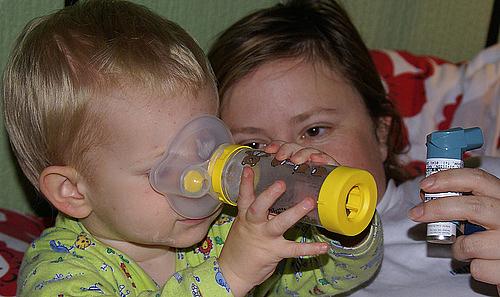For Poor Kids With Asthma, Home Can Be the Enemy

Image by viralbus via Flickr
On Sunday evening, Dateline NBC ran an hour-long story called “Breathless” that detailed the challenges of low-income children with asthma and showed why families in poorer zip codes in places such as New York City are hit far harder by the disease than upper income children.
Typically when it comes to discussions about asthma and its triggers, talk tends to highlight the usual suspects: diesel trucks, congested freeways, bustling ports, rail yards and distribution centers. But as the Dateline report emphasized, for poorer families, the home is often less of a refuge from pollution outside and more of a prime source of asthma-triggering collections of mold, cockroaches and mice dander.
Low-rent inner-city housing too often specializes in all three allergens. But getting the landlords of such unfit units to fix the problems can be an exhausting exercise in futility, even (or especially) when the landlord is a public agency such as the New York City Housing Authority (NYCHA). Meanwhile, for the children living in such conditions, the asthma attacks worsen as the infestations and mold multiplies.
The Dateline story, part of an ongoing NBC News series on U.S. poverty funded by the Ford Foundation, emphasized the class dimensions of asthma, in which zip codes serve as reliable predictors of asthma rates: Manhattan’s wealthy Upper East Side has an asthma rate of 7% among 4 to 5 years old. In the neighborhood directly north, poor East Harlem, that rate jumps to 19%.
Ray López, director of an environmental health program at an East Harlem nonprofit, told Dateline (here is a link to all 6 video segments) the key differences in these two locales are indoors:
You look at East Harlem and the Upper East Side: I think we’re basically breathing the same outdoor air. I think one of the big differences is the housing conditions, is the structural problems in many of these buildings, and the fact that landlords are slow to repair because no one is forcing them to do this work.
One might expect ill-maintained buildings to be the product of a handful of low-rent slumlords, but both families profiled by NBC News rent in public housing owned by the NYCHA. Despite a series of complaints and media coverage, both families had to endure Kafkaesque ordeals marked by bureaucracy, delays, fake fixes and courtroom skirmishes before the agency took the required steps to render their apartments safe.
According to a Dateline analysis based on a 2011 U.S. Census Bureau report, public housing apartments had almost four times as many roach infestations and three times as many leaks as private rental apartments.
In recent years, a growing body of research has shown that allergens from cockroaches can prove particularly potent in triggering or worsening asthma in low-income children. One 2011 study found that in high-asthma neighborhoods of New York City, a sensitivity to cockroach allergens was seen in nearly 24% of children, compared to just under 11% in low-asthma neighborhoods.
There’s also fresh evidence from Baltimore, Maryland, that suggests mouse dander can be even more harmful than allergens from cockroaches in some areas. NBC’s Linda Carroll summarizes the research:
In East Baltimore, one of the poorest areas of the city, at least 95 percent of homes are infected with mouse allergen, said Dr. Elizabeth Matsui, an associate professor of pediatrics and epidemiology at the Johns Hopkins Medical Institutions. Matsui and others have found that exposure to mouse dander is even worse than exposure to cockroaches when it comes to asthma.
(Caveat: While that may be true of Baltimore City, researchers caution that geographical differences mean other cities may have a different hierarchy of leading culprits.)
Dr. Matthew S. Perzanowski of Columbia University’s Mailman School of Public Health, also interviewed for “Breathless,” is conducting the NYC Neighborhood Asthma and Allergy Study to better understand why asthma rates can vary dramatically between neighborhoods right next to each other.
Describing the effort, Perzanowski writes: “We hypothesize that the differences are due to greater exposure to asthma/allergy environmental triggers, including indoor cockroach and mouse allergens and local sources of combustion byproducts.”
In response to pressure from tenants and lawsuits, New York’s housing authority announced in December it was making changes to its mold-and-moisture removal policy. The agency said it’s refocusing on eliminating the source of the mold (leaks) and making repairs within 15 days of complaints. A 60-day follow-up must ensure the problem stays fixed. Court oversight is aimed at ensuring the agency lives up to the new guidelines.
For New York City’s public housing tenants, the changes hopefully mean it will no longer take two years and a media blitz to get the mold and cockroaches cleared. It would mean some of the city’s poorest kids could breathe easier.
Related Links:
Coaches give parents in-home asthma advice
Image by viralbus via Flickr

